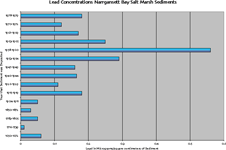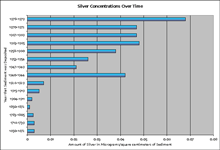 | ||||||
 |
Policy and ManagementHeavy MetalsNarragansett Bay naturally contains different amounts of various metals. These metals can be dissolved in the water column, or in particulate form in the sediments at the bottom of the Bay and nearby rivers. These metals become pollutants when they occur in concentrations large enough to have an adverse effect on the ecosystem and public health. In concentrations higher than those specified to maintain healthy systems, metals can become toxic to aquatic life and harmful to people who consume seafood from contaminated environments. Metals found in Narragansett Bay include silver (Ag). Arsenic (As), cadmium (Cd), chromium (Cr), copper (Cu), iron (Fe), manganese (Mn), nickel (Ni), lead (Pb), and zinc (Zn). These metals all occur in varying concentrations throughout the Bay. Some occur naturally as components of seawater and sedimentary rock, while some metals are present in the Bay as a result of past and present discharges. What are the sources of metals found in Narragansett Bay? There are many sources that contribute to the contamination of heavy metals into Narragansett Bay. The history of Rhode Island can give us some answers as to how heavy metals got into the Bay. Sources today include, metal inputs from rivers, industries, sewage treatment plants and the atmosphere. The history of Rhode Island is linked to the input of metals into Narragansett Bay. Textile mills, the machine tools industry, weapon factories, and the jewelry and silver industries are the major historical industries that have caused heavy metals contamination in the Bay. Lead, for example, became a problem when urbanization began in Rhode Island. During industrialization, lead contamination became prevalent as people began to use lead in textile manufacturing. The manufacturing of machinery also contributed lead to the Bay. When leaded gasoline was introduced for automobiles in the 1920s, it became another source of contamination to the Bay. As the fuel burned, it released lead into the atmosphere. The lead then settled onto surfaces and when it rained, the run-off washed into the Bay. This case is a good example of how history can be linked to metal inputs into Narragansett Bay. When lead was first used in gasoline, the amount of lead emitted into the atmosphere was about 100 tons a year. In the following years, this amount greatly increased. When regulations were made for automobiles to use unleaded gas, the amount of lead emitted into the atmosphere decreased therefore the amount of lead found in Narragansett Bay was lower. However, the lead contaminant can still be found in the sediments of the Bay.  (Click for larger image) Silver is another example of how industry is linked to the amount of metals now found in the Bay sediments. When the jewelry industry became big in Rhode Island, the amount of silver being emitted into the atmosphere increased. Core sediment samples of the Bay show that as the jewelry industry increased, silver deposition increased as well.  (Click for larger image) Lead and silver are good examples of how the history of industrialization in Rhode Island is linked to the amount of heavy metals found in the Bay. Today there are many sources of heavy metal input into Narragansett Bay. These include rivers, industries, sewage treatment plants, the atmosphere and runoff. Heavy metals that have settling from the surface wash-off into rivers and streams during heavy rainfalls. The contaminated water ultimately makes its way to the Bay. Metals can contaminate the surface water of the Bay. However, the atmosphere may be an important source for metals carried to the Bay by rivers. The input of industrial waste is not directly discharged into Narragansett Bay. However, some industries discharge into the rivers that flow into the Bay. Metals that are found in this discharge are usually small amounts of Copper (Cu), Lead (Pb), and Zinc (Zn). Industrial waste, however, does not cause as large as a problem for the Bay as the wastewater from sewage treatment plants. There are thirty-two sewage treatment facilities within the Narragansett Bay drainage basin. Twenty-four of them discharge into rivers and streams that flow into the Bay and the remaining discharge directly into Narragansett Bay. Many times the water goes untreated and is discharged into the Bay contaminated. There are, however, regulations that some sewage treatment facilities have adapted that make sure the effluent is treated and metal concentrations are low. Polluted waters can enter Narragansett Bay through the rivers that drain into it. There are three main freshwater sources to the Bay: the Blackstone, Taunton and Pawtuxet Rivers. Metal inputs from rivers are determined by the variation in river flow. How do metals affect Narragansett Bay? High levels of toxic contaminants are found buried in the sediments of the Bay. A few feet deep in the sediments of the Bay is where history can be found. Sediment cores have been taken that show the history of the Bay. The cores tell a story of when metals were deposited into the Bay. Sediment that contains heavy metals can cause a problem when dredging projects are proposed in these highly polluted areas. If these toxic substances are re-suspended in the water due to dredging, it can cause more pollution problems in the Bay. The untreated wastewater that enters the Bay also causes pollution to the Bay. Water running off the land during rain storms can cause the surface water to become contaminated affecting the organisms that live in the Bay. When these organisms are consumed by people they may cause health problems. What is being done about metal contamination in Narragansett Bay? Effective implementation of industrial pretreatment at wastewater treatment facilities has caused the total amount of metal loadings to the surface water of Narragansett Bay to fall. Since the mid-70s, treatment plants have been required to report the concentrations of metals in their effluents. Sewage treatment plants like Field's Point in Providence monitor the discharge of metals that go directly into the Bay. They have been successful in reducing the amounts of heavy metals entering the Bay. Smaller treatment plants are also taking samples a few times a year or more. There are now state and federal water pollution laws which have caused the development and implementation of new technologies to control pollution.
|
|||||